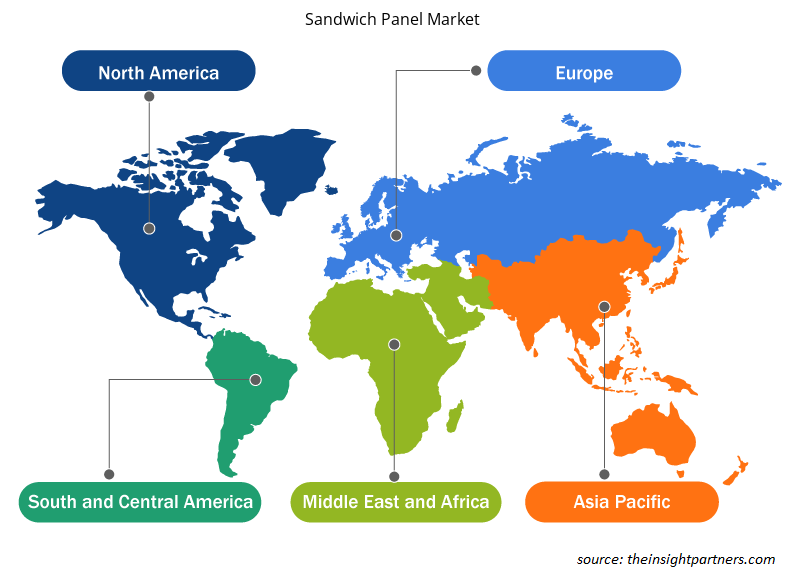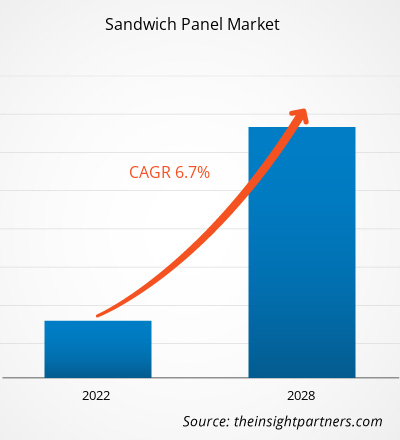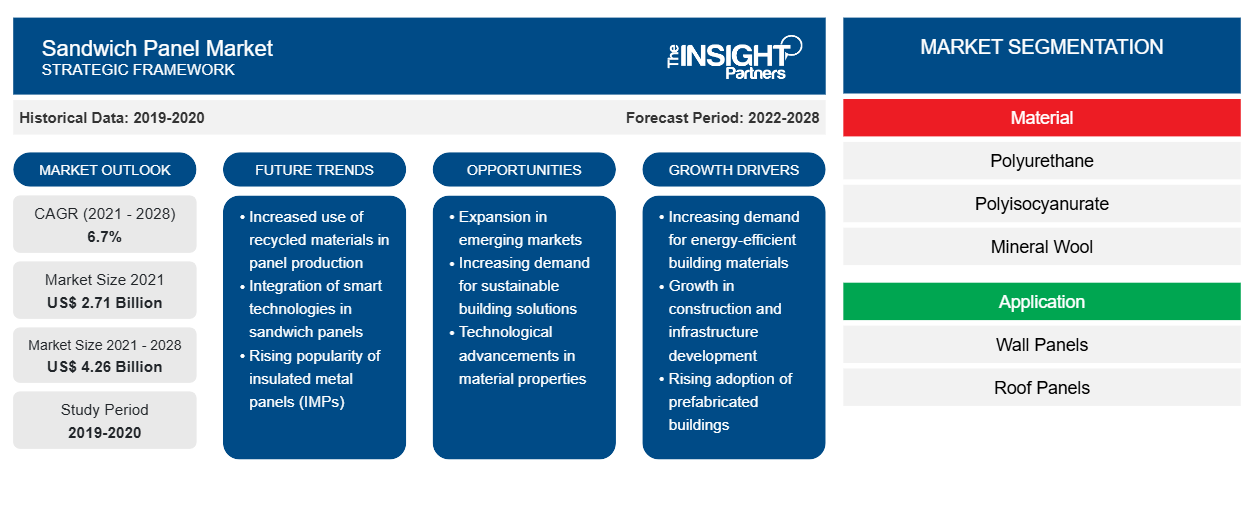Il mercato dei pannelli sandwich è stato valutato a 2.711,11 milioni di dollari nel 2021 e si prevede che raggiungerà i 4.256,62 milioni di dollari entro il 2028; si prevede una crescita a un CAGR del 6,7% dal 2021 al 2028.
I pannelli sandwich sono una struttura a triplo strato che contiene una sottile pelle esterna rigida e dura e un materiale isolante centrale nel mezzo. Questa struttura protegge l'interno dal rumore, dalle condizioni meteorologiche estreme e dall'improvviso scoppio di incendi.
Nel 2020, l'Asia Pacifica ha detenuto la quota di fatturato più grande del mercato globale dei pannelli sandwich . La crescita del mercato nella regione può essere attribuita alla rapida industrializzazione e alle attività di costruzione di edifici. La regione sta assistendo a un aumento della costruzione di celle frigorifere, magazzini, centri commerciali, edifici industriali e commerciali. Inoltre, la regione è nota come il più grande produttore di prodotti agricoli a livello mondiale, il che si traduce in un maggior numero di costruzioni di locali agricoli in tutta la regione per immagazzinare i raccolti. Quindi, i fattori sopra menzionati stanno favorendo la domanda di pannelli sandwich nella regione.
Personalizza questo report in base alle tue esigenze
Riceverai la personalizzazione gratuita di qualsiasi report, comprese parti di questo report, o analisi a livello nazionale, pacchetto dati Excel, oltre a usufruire di grandi offerte e sconti per start-up e università
- Scopri le principali tendenze di mercato in questo rapporto.Questo campione GRATUITO includerà analisi di dati che spaziano dalle tendenze di mercato alle stime e alle previsioni.
Impatto della pandemia di COVID-19 sul mercato dei pannelli sandwich
La pandemia di COVID-19 ha drasticamente alterato lo stato del settore chimico e dei materiali e ha avuto un impatto negativo sulla crescita del mercato dei pannelli sandwich. Settori come l'edilizia, la refrigerazione e la chimica sono stati colpiti dall'improvvisa distorsione delle efficienze operative e dalle interruzioni nelle catene del valore attribuibili alla chiusura improvvisa dei confini nazionali e internazionali. Il significativo calo della crescita di diversi settori industriali ha avuto un impatto sulla domanda di pannelli sandwich nel mercato globale. La domanda di pannelli sandwich è stata influenzata negativamente a causa della chiusura totale delle attività di costruzione e dell'arresto dell'espansione o della nuova costruzione di impianti e fabbriche. Tuttavia, la domanda di prodotti in pannelli sandwich è stata sostanziale da parte degli stabilimenti di produzione farmaceutica e alimentare e delle bevande, poiché questi settori hanno assistito a una crescita durante il blocco. Ciò ha aiutato il mercato dei pannelli sandwich a sostenersi in una certa misura.
Approfondimenti di mercato
Crescenti applicazioni di pannelli sandwich per la conservazione a freddo
I pannelli sandwich sono sempre più utilizzati in molti contesti commerciali, tra cui grandi aree di refrigerazione. Sono anche ideali per i magazzini per conservare articoli sensibili che devono essere mantenuti a una temperatura costante, come prodotti congelati e altri articoli sensibili alla temperatura. Aumento della domanda di lavorazione alimentare al dettaglio per prodotti che necessitano di efficienti strutture di stoccaggio a freddo. Inoltre, durante la pandemia, l'aumento delle vendite di generi alimentari online e l'espansione dei canali di e-commerce hanno comportato la necessità di espandere le strutture di stoccaggio a freddo.
I pannelli sandwich sono utilizzati nei camion refrigerati, noti anche come rimorchi refrigerati, per il trasporto di articoli sensibili alla temperatura. La crescente domanda di prodotti pronti da mangiare/cuocere, latticini e articoli farmaceutici sta spingendo la necessità di camion refrigerati. Ciò, a sua volta, stimolerà la crescita del mercato dei pannelli sandwich.pharma items is propelling the need for reefer trucks. This, in turn, will boost the growth of the sandwich panels market.
Approfondimenti sulle applicazioni
In base all'applicazione, il mercato globale dei pannelli sandwich è stato segmentato in pannelli per pareti, pannelli per tetti e altri. Il segmento dei pannelli per pareti ha detenuto la quota maggiore nel mercato globale dei pannelli sandwich nel 2020. Il pannello per pareti fornisce isolamento acustico, che riduce al minimo gli effetti dannosi del rumore sugli esseri umani, esclude i suoni indesiderati e riduce la diffusione del suono dalle aree rumorose. Si prevede che la crescente necessità di locali insonorizzati e termicamente in vari settori spingerà la crescita del segmento dei pannelli per pareti durante il periodo di previsione.
Kingspan Group, Assan Panel, Isopan, Tata Steel, ArcelorMittal, Attonedil, Italpanneli SRL, DANA Group of Companies, Zhongjie Group e Multicolor Steel India Pvt. Ltd. sono tra i principali attori che operano nel mercato dei pannelli sandwich. Queste aziende offrono un'ampia gamma di portafogli di prodotti e hanno una presenza globale diffusa.
Approfondimenti regionali sul mercato dei pannelli sandwich
Le tendenze regionali e i fattori che influenzano il mercato dei pannelli sandwich durante il periodo di previsione sono stati ampiamente spiegati dagli analisti di Insight Partners. Questa sezione discute anche i segmenti e la geografia del mercato dei pannelli sandwich in Nord America, Europa, Asia Pacifico, Medio Oriente e Africa e America meridionale e centrale.

- Ottieni i dati specifici regionali per il mercato dei pannelli sandwich
Ambito del rapporto sul mercato dei pannelli sandwich
| Attributo del report | Dettagli |
|---|---|
| Dimensioni del mercato nel 2021 | 2,71 miliardi di dollari USA |
| Dimensioni del mercato entro il 2028 | 4,26 miliardi di dollari USA |
| CAGR globale (2021 - 2028) | 6,7% |
| Dati storici | 2019-2020 |
| Periodo di previsione | 2022-2028 |
| Segmenti coperti | Per materiale
|
| Regioni e Paesi coperti | America del Nord
|
| Leader di mercato e profili aziendali chiave |
|
Densità degli attori del mercato: comprendere il suo impatto sulle dinamiche aziendali
Il mercato dei pannelli sandwich sta crescendo rapidamente, spinto dalla crescente domanda degli utenti finali dovuta a fattori quali l'evoluzione delle preferenze dei consumatori, i progressi tecnologici e una maggiore consapevolezza dei vantaggi del prodotto. Con l'aumento della domanda, le aziende stanno ampliando le loro offerte, innovando per soddisfare le esigenze dei consumatori e capitalizzando sulle tendenze emergenti, il che alimenta ulteriormente la crescita del mercato.
La densità degli operatori di mercato si riferisce alla distribuzione di aziende o società che operano in un particolare mercato o settore. Indica quanti concorrenti (operatori di mercato) sono presenti in un dato spazio di mercato in relazione alle sue dimensioni o al valore di mercato totale.
Le principali aziende che operano nel mercato dei pannelli sandwich sono:
- Gruppo Kingspan
- Pannello di Assan
- Isopan
- Acciaio Tata
- ArcelorMittal
Disclaimer : le aziende elencate sopra non sono classificate secondo un ordine particolare.

- Ottieni una panoramica dei principali attori del mercato dei pannelli sandwich
Segnala i riflettori
- Tendenze industriali progressive nel mercato dei pannelli sandwich per aiutare gli operatori a sviluppare strategie efficaci a lungo termine
- Strategie di crescita aziendale adottate dai mercati sviluppati e in via di sviluppo
- Analisi quantitativa del mercato dei pannelli sandwich dal 2019 al 2028
- Stima della domanda globale di pannelli sandwich
- Analisi delle cinque forze di Porter per illustrare l'efficacia degli acquirenti e dei fornitori che operano nel settore
- Sviluppi recenti per comprendere lo scenario competitivo del mercato
- Tendenze e prospettive del mercato, nonché fattori che guidano e frenano la crescita del mercato dei pannelli sandwich
- Assistenza nel processo decisionale evidenziando le strategie di mercato che sostengono l'interesse commerciale, portando alla crescita del mercato
- La dimensione del mercato dei pannelli sandwich in vari nodi
- Panoramica dettagliata e segmentazione del mercato, nonché dinamiche del settore dei pannelli sandwich
- Dimensioni del mercato dei pannelli sandwich in varie regioni con promettenti opportunità di crescita
Mercato globale dei pannelli sandwich
- Materiale
- Poliuretano
- Poliisocianurato
- Lana minerale
- Altri
- Applicazione
- Pannelli da parete
- Pannelli del tetto
- Altri
- Uso finale
- Residenziale
- Non residenziale
Profili aziendali
- Gruppo Kingspan
- Pannello di Assan
- Isopan
- Acciaio Tata
- ArcelorMittal
- Attonedil
- Italpannelli SRL
- Gruppo di società DANA
- Gruppo Zhongjie
- Multicolor Steel India Pvt. Ltd.
- Analisi storica (2 anni), anno base, previsione (7 anni) con CAGR
- Analisi PEST e SWOT
- Valore/volume delle dimensioni del mercato - Globale, Regionale, Nazionale
- Industria e panorama competitivo
- Set di dati Excel
Report recenti
Testimonianze
Motivo dell'acquisto
- Processo decisionale informato
- Comprensione delle dinamiche di mercato
- Analisi competitiva
- Analisi dei clienti
- Previsioni di mercato
- Mitigazione del rischio
- Pianificazione strategica
- Giustificazione degli investimenti
- Identificazione dei mercati emergenti
- Miglioramento delle strategie di marketing
- Aumento dell'efficienza operativa
- Allineamento alle tendenze normative





















 Ottieni un campione gratuito per - Mercato dei pannelli sandwich
Ottieni un campione gratuito per - Mercato dei pannelli sandwich